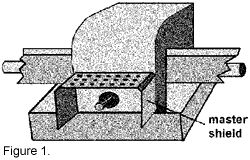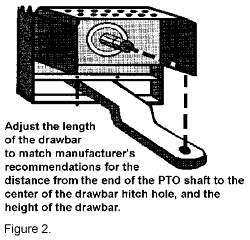One of the most hazardous areas on your tractor is the power takeoff shaft. Without proper guards, shields, and constant operator awareness of the risks involved with operating PTO-driven equipment, this spinning shaft can quickly grab and entangle an unsuspecting farmer or family member. Too often entanglement results in a severe injury or death. Records show that eight Michigan farmers were killed in PTO related accidents from 1985 to 1991.
There are two common types of accidents resulting from PTO shafts, entanglements and being struck by the shaft after it has separated during operation.
Getting caught by the shaft (entanglement) is the most common type of PTO accident, and generally causes the most severe injuries and deaths. Injuries resulting from shafts separating during operation frequently result from the shaft striking someone working or standing in the immediate area. Both of these types of accidents can be avoided if the operator properly maintains the equipment and limits access the PTO area when the equipment is running.
SHIELDS
 Equipment manufacturers have made strides in reducing the risks
of PTO mishaps, but it is up to the operator to make sure that
all guards and shields are properly maintained. Removing a shield
or guard increases operator risk.
Equipment manufacturers have made strides in reducing the risks
of PTO mishaps, but it is up to the operator to make sure that
all guards and shields are properly maintained. Removing a shield
or guard increases operator risk. SHIELDING PTO-OPERATED EQUIPMENT
The ends of the driveline shield are bell-shaped to cover the universal joints of the shaft. Because universal joints are irregularly shaped and prone to grab objects, operators should never modify the bell-shaped shield to make maintenance, greasing parts or connecting the shaft easier.
Guards Manufacturer installed guards must be replaced when removed for maintenance. These guards are designed to protect the operator and equipment. Guards not only reduce the risk of an injury, they also keep dust and other foreign objects from damaging gears and other moving parts.
Maintenance Like any moving part, the driveline shield must be maintained to ensure proper operation. PTO equipment is frequently operated in inclement weather and exposed to dust, chaff and other foreign materials which can quickly damage the bearings that allow the shaft to spin freely inside the shield. Rust, dirt and crop debris must be cleaned frequently to allow the bearings to spin freely. Replace any damaged or worn shields with the manufacturer:s recommended parts. Storing equipment inside will also help extend the lifetime of the equipment and reduce maintenance costs.
Positioning
the Drawbar to the PTO shaft
 The length and height of a tractor:s drawbar may need to be
adjusted to match the implement manufacturer:s specifications.
It is important to make these adjustments to ensure that the
PTO driveline does not compress or separate during operation.
To make this adjustment, check the implement manufacturer:s
recommendations and adjust the height of the drawbar and the
distance from the PTO stub shaft to the center of the drawbar
hitch hole (see Figure 2).
The length and height of a tractor:s drawbar may need to be
adjusted to match the implement manufacturer:s specifications.
It is important to make these adjustments to ensure that the
PTO driveline does not compress or separate during operation.
To make this adjustment, check the implement manufacturer:s
recommendations and adjust the height of the drawbar and the
distance from the PTO stub shaft to the center of the drawbar
hitch hole (see Figure 2).
Failure to match the drawbar to the implement can result in the driveline being compressed or separated when the tractor makes a sharp turn or comes to the top or bottom of a hill. Separation or compression frequently damages the protective shield to the point where it no longer slides together or allows the shaft to spin freely inside the shield.
Farmers in a hurry to complete planting or harvesting operations may be tempted to simply remove a damaged shield so they can continue working. This places the operator or anyone near the equipment at an unnecessary risk. Take time to make the necessary adjustments to the tractor drawbar before using the equipment or be prepared to stop and replace any damaged shields.
Shear
Pins and Bolts
 Most PTO-driven equipment has some form of a shear pin to prevent
damage to the shaft or gearbox. Always follow the manufacturer:s
recommendations for size and hardness when replacing a damaged
shear pin or bolt. Using a pin or bolt that is longer than necessary
creates a potential catch point that may snag the operator:s
boot lace or clothing, resulting in a possible entanglement
(Figure 3).
Most PTO-driven equipment has some form of a shear pin to prevent
damage to the shaft or gearbox. Always follow the manufacturer:s
recommendations for size and hardness when replacing a damaged
shear pin or bolt. Using a pin or bolt that is longer than necessary
creates a potential catch point that may snag the operator:s
boot lace or clothing, resulting in a possible entanglement
(Figure 3).
KEYS TO PTO SAFETY

| Figure 5. Checklist for safe PTO operation | ||
| Yes | No | |
|---|---|---|
| Is the tractor master shield in place? | ___ | ___ |
| Is the drawbar height and length set to the implement manufacturer's specifications? | ___ | ___ |
| Does the driveline shield float freely (with the engine off) by hand? | ___ | ___ |
| Is the driveline shield free of dents and other damage? | ___ | ___ |
| Are all guards and shields in place? | ___ | ___ |
| Are shear bolts/pins of proper length and hardness? | ___ | ___ |
| Are you wearing snug fitting clothing with no hanging drawstrings or frayed cuffs? | ___ | ___ |
| Are you wearing slip-on boots instead of shoes or boots with dangling shoe laces? | ___ | ___ |
| Will you take the time to walk around the tractor instead of stepping over the spinning PTO shaft? | ___ | ___ |
| Did you answer "Yes" to all of these questions? If not, take time to repair the equipment or make changes in your operating practices to protect yourself from a PTO shaft entanglement. | ___ | ___ |
Michigan State University, Agricultural Engineering Department.
Howard J. Doss, Agricultural Safety Specialist, Michigan State University Extension, East Lansing, Michigan 48824. 5/93. Funded by the National Institute of Occupational Safety and Health - #UO5/CC-4506052-02.
This information is for educational purposes only. Reference to commercial products or trade names does not imply endorsement by the MSU Extension or bias against those not mentioned.
Disclaimer and Reproduction Information: Information in NASD does not represent NIOSH policy. Information included in NASD appears by permission of the author and/or copyright holder. More